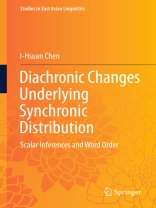This book deals with synchronic variation in Chinese through a diachronic lens, based on the evidence from a quantitative, longitudinal corpus study. Departing from the traditional analysis in diachronic changes in Chinese linguistics, the cognitive constructionist approach employed in this book is able to capture incremental changes by combining syntax, semantics, and pragmatics. Topics such as word order, focus, scopes of quantifiers, information structure, and negation have been important issues in linguistics, but they are rarely integrated as a whole. The book makes their diachronic interactions available to the students and researchers in the fields of general and Chinese linguistics.
Inhaltsverzeichnis
Introduction.- The Development of ‘One’-phrases as Minimizers in Chinese.- The Development of the Polysemous Fixed ‘One’-phrase in Mandarin Chinese.- The Emergence of Scalar Particles DOU and YE in OV Order in Mandarin Chinese.-‘One’-phrases as Minimizers in Numeral Classifier Languages.- Synchronic Variations: ‘One’-phrases as Minimizers in Modern Mandarin Chinese.- Conclusion.
Über den Autor
I-Hsuan Chen is currently a postdoctoral fellow in the Department of Chinese and Bilingual Studies at the Hong Kong Polytechnic University. She received her Ph D degree from the Department of Linguistics, University of California, Berkeley in 2015. Before joining the Hong Kong Polytechnic University, she held both research and lectureship positions at the Department of Linguistics and at the Department of East Asian Cultures and Languages, University of California, Berkeley. Her research areas include Chinese linguistics, historical linguistics, and cognitive linguistics primarily based on corpus analysis. She has published journal papers and book chapters covering synchronic and/or diachronic topics in semantics, syntax, and pragmatics in the field of Chinese Linguistics. She is a co-editor of
the Cambridge Handbook of Chinese Linguistics, edited by Chu-ren Huang, Yen-hwei, and I-Hsuan Chen. The material for this book is based on her dissertation research, which was funded by the Chiang Ching-Kuo Foundation for International Scholarly Exchange.












